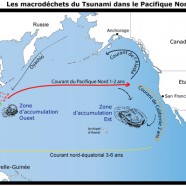Millions of Stowaway Passengers Circling Around the Pacific Ocean
The tsunami which followed the Japanese earthquake devastated around 300km of coastal cities, towns, farmlands and greenhouses along Japan’s Pacific coastline. The wave was reported to have spread up to 10km (six miles) inland and inundated around 500km². Not only did the earthquake and tsunami create an estimated 25 million tonnes of rubble, but when the tsunami receded it dragged with it countless quantities of waste in the flooded zone.
The After Shock
Climatic, geological, or anthropogenic natural disasters produce in a couple of seconds, hours or days, enormous amounts of waste, so much so that authorities are unable to handle the quantity with ordinary means. The rupture of “lifelines”, namely water, electricity, transportation routes and communication lines, send survivors into a deep confusion. The accumulation of rubble and waste increases the shock of the populations and postpones the first steps towards the return to normalcy.
The 3 million tonnes of rubble generated by the earthquake in Los Angeles in January 1994 led the city to reinforce and multiply its recycling capacities. Provisional transit and elimination sites for future earthquakes were pre-selected.
The After Shock
Climatic, geological, or anthropogenic natural disasters produce in a couple of seconds, hours or days, enormous amounts of waste, so much so that authorities are unable to handle the quantity with ordinary means. The rupture of “lifelines”, namely water, electricity, transportation routes and communication lines, send survivors into a deep confusion. The accumulation of rubble and waste increases the shock of the populations and postpones the first steps towards the return to normalcy.
The 3 million tonnes of rubble generated by the earthquake in Los Angeles in January 1994 led the city to reinforce and multiply its recycling capacities. Provisional transit and elimination sites for future earthquakes were pre-selected.
A stream of Information
The ocean is still considered as a trash can. Radioactive releases by Japan are increased by a decrease of vigilance. What is occurring in the Pacific Ocean is probably inevitable. However it is not excusable nor should it be viewed as routine as many scientific experts in dispersion and farfetched comparison are currently stating. This type of practice would be impossible in the North East Atlantic. Contracting Parties to the OSPAR Convention follow carefully step by step the slow progression of iodine 131, of cesium 137 and of plutonium released by nuclear installations along the Channel and the North Sea to the Arctic Ocean.
France is to Blame
Thanks to the technological help from France, in 1970 in Tokaï-Mura, south of Fukushima, Japan opened a pilot irradiated fuel-reprocessing factory.
In 1987, Cogema (COmpanie GEnérale des MAtières nucléaires) signed a contract for 1.4 billion francs, equivalent to 213 million Euros, to help construct a new reprocessing factory in Rokkasho-Mura, north of Fukushima – a replica of la Hague’s inland factory near Cherbourg. It should have started service in 2005, but today we are still waiting. As a result, the Fukushima-Daiichi accident site also houses a pool of irradiated fuel, common to the six reactors. The pool is supersaturated and serves as buffer storage pending the start of the Rokkasho-Mura factory. The vice president of Tepco, Tokyo Electric Power Company, declared in 2002 while the local and hostile nuclear referenda were multiplying that “the extraction of plutonium was vital.” The Rokkasho factory must then serve to extract the irradiated plutonium fuel and to re-inject the new fuel associated with the enriched, mixed oxide uranium plutonium fuel. In waiting for the eventual opening of the Rokkasho-Mura factory, France furnished the Japanese reactors with MOX. On March 10th 2011, the day before the earthquake, Areva, the leading French nuclear company, announced to the French High Committee for the Transparence of Information on Nuclear Safety the imminent departure of a new sea transport of MOX between Cherbourg and Japan, which would include fuel for the 3rd reactor at Fukushima-Daiichi.









